
Building Effective Study Guides for Online Learning and Assessment
By Shalin Hai-Jew, Instructional Designer at K-State
Colleague 2 Colleague (C2C) SIDLIT
Aug. 2 - 3, 2012
Study guides are common features of science-based (and some social science) courses. These are information sets created by learners to help them prepare for upcoming exams. If effectively designed (by the faculty member usually) and executed (by the learners) with faculty oversight, such study guides offer effective notes for student learning. They serve as powerful resources to enhance memory. Study guides are effective because they help learners synthesize (sometimes contradictory) information from various information sources and are expressed in the learners' own words to enable instructor evaluation of their actual comprehension. These guides enhance learner citations of research sources. Such digital study guides may integrate text, imagery, URLs, and other resources. These help learners take ownership of the learning and help them express their understandings through their own interpretive lenses. This presentation will include some live examples of study guides and their various strengths and weaknesses. There will be ideas for how to take the "retro" concept of a study guide and re-make study guides into interactive learning resources, with special strengths in intensive, concentrated, or accelerated courses.

Overview
"Retro" Study Guides
Contemporary Study Guides for Online Learning
Example 1: Intro to Public Health
Example 2: K-State Hale Library's Customized Study Guides
Example 3: Bridge to Success / OER (Open Educational Resources) Resources
Steps to Building Effective Study Guides for Online Learning and Assessment
Traditional study guides were created to enhance learning by highlighting the main ideas from a complex curriculum to enable learners to focus on the critical takeaways from a lesson. Instructors would often embed learning strategies with their study guides. Studies guides often expressed pedagogical strategies. They reinforced the critical learning. Often, they reduced learner anxieties and lightened cognitive loads for learners by further scaffolding the learning.
Often, study guides were created by third-party content creators / publishers who wrote textbooks, and study guides not only enhanced learner access to the materials, but these also were used by instructors as lesson planners.
Most traditional study guides were strictly "templated" with the following features:
A Traditional Study Guide Template (downloadable)
Some included sidebars or "boxes" with examples. Others included pull-outs of main points in the margins. Many study guides of old looked a lot like print chapters or excerpts of such chapters. Essentially, these showed a structuring of information. Some study guides look like actual chapters in books and may have been used that way.
Some study guides are merely a list of questions. These may include critical thinking questions.
Others are incomplete notes, with an incomplete outline of the instructor's lectures with fill-in-the-blanks work for learners. (These were popular in face-to-face large lecture courses, especially in survey courses.)
Most traditional study guides have pre-determined answers. Some instructors made these completed or filled-in study guides available to students later on. (Most of these were used for convergent learning. Convergent learning involves established understandings and facts that are generally memorized.)
A review of the literature on study guides did not result in many resources. What this review did surface were various study guides that have been archived now as .pdfs.
Independent learning in various unique contexts. Various rationales were identified for why study guides should be used. In one 90-module 12-week course covering the biological sciences for nurses, study guides were used as part of a learning lab kit including audio tapes (with "narration of the subject matter and cues for student responses"), slides, films, anatomical charts and specimens (Mentzer & Scuglia, 1975). The study guides provided "objectives for student responses" (p. 358). This learning was self-paced, and the nurses could take an objective test at the end of the time period to test their knowledge and skills. It would seem that this training could be done while nurses continued their professions in their respective and unique circumstances.
Enhancing reading comprehension. For one researcher, study guides were used to enhance learner reading comprehension (Tutolo, 1977). In light of what is known today about reading disabilities, dyslexia, and other symbolic processing and reasoning challenges, this rationale is still relevant. This author differentiated between "interlocking" and non-interlocking" types of study guides, with the first "keyed to the textbook" based on defined learning objectives, and the other more free-form (Tutolo, 1977, p. 503). The study guide was built on the assumption that "comprehension will be enhanced when directions which stipulate goals are in close proximity to the textual material containing the relevant information" (p. 504). In other words, instructors could individualize the instruction and highlight what they see as relevant. The interlocking method focused on three levels of reading: first at the level of literal meanings, then at the more analytical levels of interpretive and applicative meanings. These even involved the analysis of paragraph patterns. By contrast, the noninterlocking study guide does not create a hierarchy of reading and analysis but rather uses a more creative approach built around whatever would enhance the learning.
Adapting mass media contents for the classroom. Yet another example involved the adaptation of feature-length films and other mass media contents to have learning value in a classroom (Briley, 1998). This strategy has been applied to historical literature, too, which may need updating for relevance to a modern mind set and readership. Another work mentioned the application of a moral reasoning model to adolescent literature, using the model as an overlay. This model enabled discussion of various literary plots across multiple works using the moral reasoning model and the study guides as bridges.
Here, the study guide served as a bridge between the learners to the learning contents that were designed for another (entertainment) purpose. This could re-frame experiences. This guide could adapt a work for user use. It enabled a leveraging of outside contents.
Enhancing real-world understandings. Some study guides intersperse scientific or medical information with real-world vignettes that humanize the facts. Some study guides used case studies and scenarios (the first factual, the latter potentially fictional and based on imagination mixed with facts) to enhance the learning to be more complex, real-world, and transferable (and applied).
Briley, R.F. (1998, May). The study guide Amistad: a lasting legacy. The History Teacher: 31(3), 390 - 394. Society for History Education.
Mentzer, D.S. & Scuglia, R.C. (1975, Sept.) Teaching life science to student nurses: a modular approach. The American Biology Teacher: 37(6), 358 - 360. The University of California Press. National Association of Biology Teachers.
Tutolo, D.J. (1977, Mar.) The study guide: Types, purpose and value. Journal of Reading: 20(6), 503 - 507. International Reading Association.
Well-designed study guides have learning value for both learners and instructors.
For a learner, a study guide lightens the cognitive load of acquiring the learning. It informs their naïve mental models with the more complex conceptual models of the subject matter experts (SMEs).
For an instructor, using study guides may result in better prepared students. Further, reviewing the study guides for the instructor may provide a sense of what is being communicated through the course lectures and study materials. These insights may help in the fine-tuning of emphasis and focus in the class.
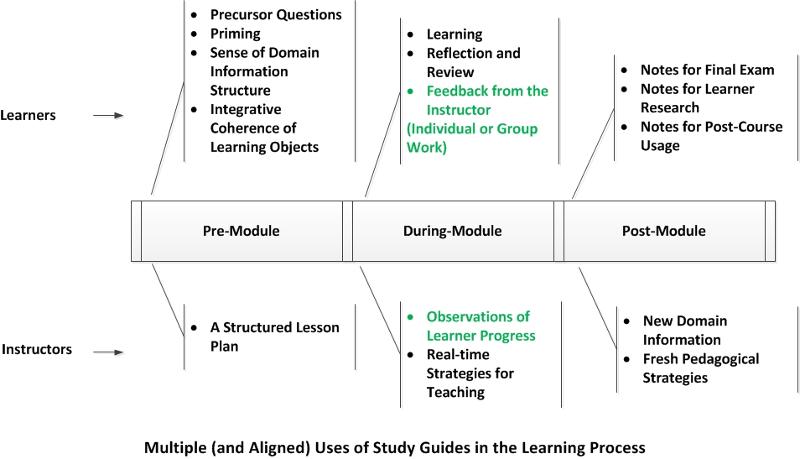
Figure 1. Multiple (and Aligned) Uses of Study Guides in the Learning Process
So what about study guides today? Are they still in use? How are they being used? How are they being developed?
Study guides still have validity and usefulness today. After all, students still need the cognitive load lightened, and they can benefit from the insights of subject matter experts.
In any of these circumstances, study guides may add value.
Study guides are still used to help learners synthesize the learning pulled from disparate sources. With so many solid types of contents online, instructors in face-to-face (F2F) and online (and hybrid / blended) courses draw from the Web. With so many voices and sources in play, learners have to put in extra work to create coherence and to logically synthesize information.
An example comes from "Ideologies: Their Origins and Impact" [a standard full-semester-term face-to-face (F2F) course]. Here, the instructor required the work to be done prior to the midterms and final. The instructor responded to the contents, and she advocated for high quality responses. That feedback loop and substantive instructor-to-learner feedback enhanced the learning value of the straightforward set of questions. Without that loop, the study guide questions could be seen as just a list of comprehension questions (that helped synthesize the learning). The fact that the study guide responses were graded and used strategically before assessments enhanced their learning value.
Study guides are still used to integrate mass media for learning, although that mass media may now be an electronic game (which needs setup, coordination, and debriefing for learning values). Study guides are used to guide learners through digital simulations like laboratory experiments. They are used for on-ground local learning such as on a field trip.
The wide availability of authoring tools for digital contents enables a wide variety of study guides. The following elements may be used in a stand-alone way or in a mixed-content way:
Digital object types
Systems
What are some ways that designers of study guides may change things up to enhance the learning (and the form)? The idea is to avoid locking in to certain assumptions but to be open to various types of structuring learning.
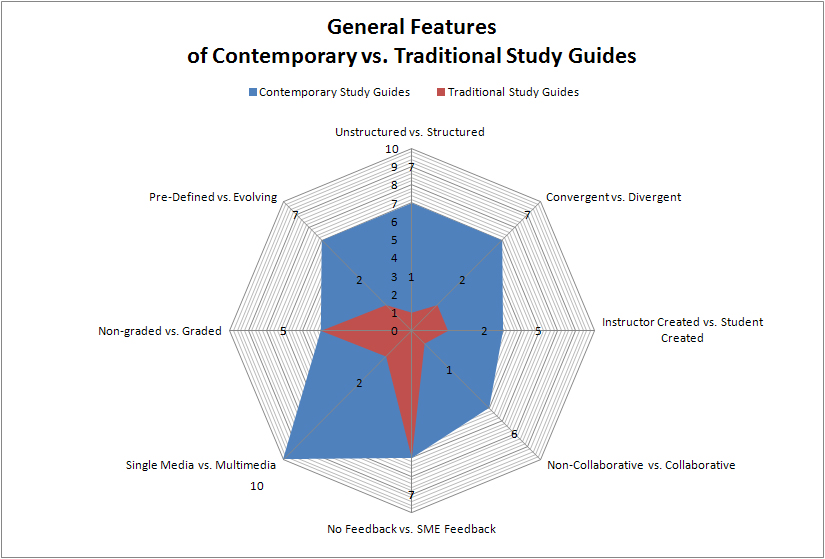
* These numbers are not the result of empirical research but a generalization from observations of study guides found in online repositories. This "filled radar chart" illustration is used to introduce the general dimensions and to offer a preliminary conceptualization of how this might look.
|
Unstructured vs. Structured |
Convergent vs. Divergent |
Instructor Created or Student Co-Created |
Non-Collaborative vs. Collaborative |
No Feedback vs. SME Feedback |
Single Media vs. MultiMedia |
Non-Graded vs. Graded |
Pre-Defined vs. Evolving |
|
|
Contemporary Study Guides |
7 |
7 |
5 |
6 |
7 |
10 |
5 |
7 |
|
Traditional Study Guides |
1 |
2 |
2 |
1 |
7 |
2 |
5 |
2 |
Unstructured vs. Structured: Sense of pre-determined order
Divergent vs. Convergent: Open-ended or close-ended study guides; complex learning that requires innovation or declarative knowledge learning requiring rote memorization
Student Co-Created vs. Instructor Created: Study guide sourcing by learners or by the instructor (with some professors using the students' work to create assessments)
Collaborative vs. Non-Collaborative: Study guides used by groups of learners vs. individual learners only
No Feedback vs. SME Feedback: Whether the instructor responds to the student work in their study guides
Multimedia vs. Single Media: The types of multimedia used for the creation of the study guide
Affects Grades Formally vs. Not: The grading of study guides as part of the course
Evolving vs. Pre-Defined: The nature of the study guide as an evolving document with changing elements (and new contents) over time (including over many academic terms and cohort groups of learners) or a pre-defined set of elements with generally pre-determined answers
|
"Study Guides"
One challenge though is that the term is used very broadly—for tutorials and online lessons and other types of learning elements. Give it a try. Put in "study guide" as the search term in the following repository, and you may find what I did.
Multimedia Educational Resource for Learning and Online Teaching (MERLOT) http://www.merlot.org/merlot/index.htm
|
In late June, I posted a call-out to the DEOS electronic mailing list and asked for any examples of study guides used for online learning. I received some links which I'll share in the next few pages. However, two other responses were instructive. One, a head of an online program at a major university, wrote to say that they moved away from study guides five years ago and "toward a more interactive experience" for their students. They basically decomposed their study guide into the learning management system, and they encouraged learners to interact among themselves and with their instructor. Another referred me to excerpts from a published book for basic information for learners who are taking online courses. Both of these respondents saw the "study guide" question as one about the guides to online learning...not domain-specific study guides for particular online courses (which is more what I meant).
A few of the examples of contents follow in the next few pages.
The following is a more traditional and close-ended study guide with defined answers.
The following is an open-ended Study Guide.
(Note: These were presented by permission of Dr. Beth Montelone, co-PI of the grant under which the Pathways to Public Health "Intro to Public Health" was created.)
These modularized and assignment specific study guides relate to domain-specific research projects, achieved with the full support of the librarians.
Public Speaking 1A
Introduction to American Ethnic Studies
Introduction to Cultural Anthropology
Usage Statistics on the Back End
Guide Hits
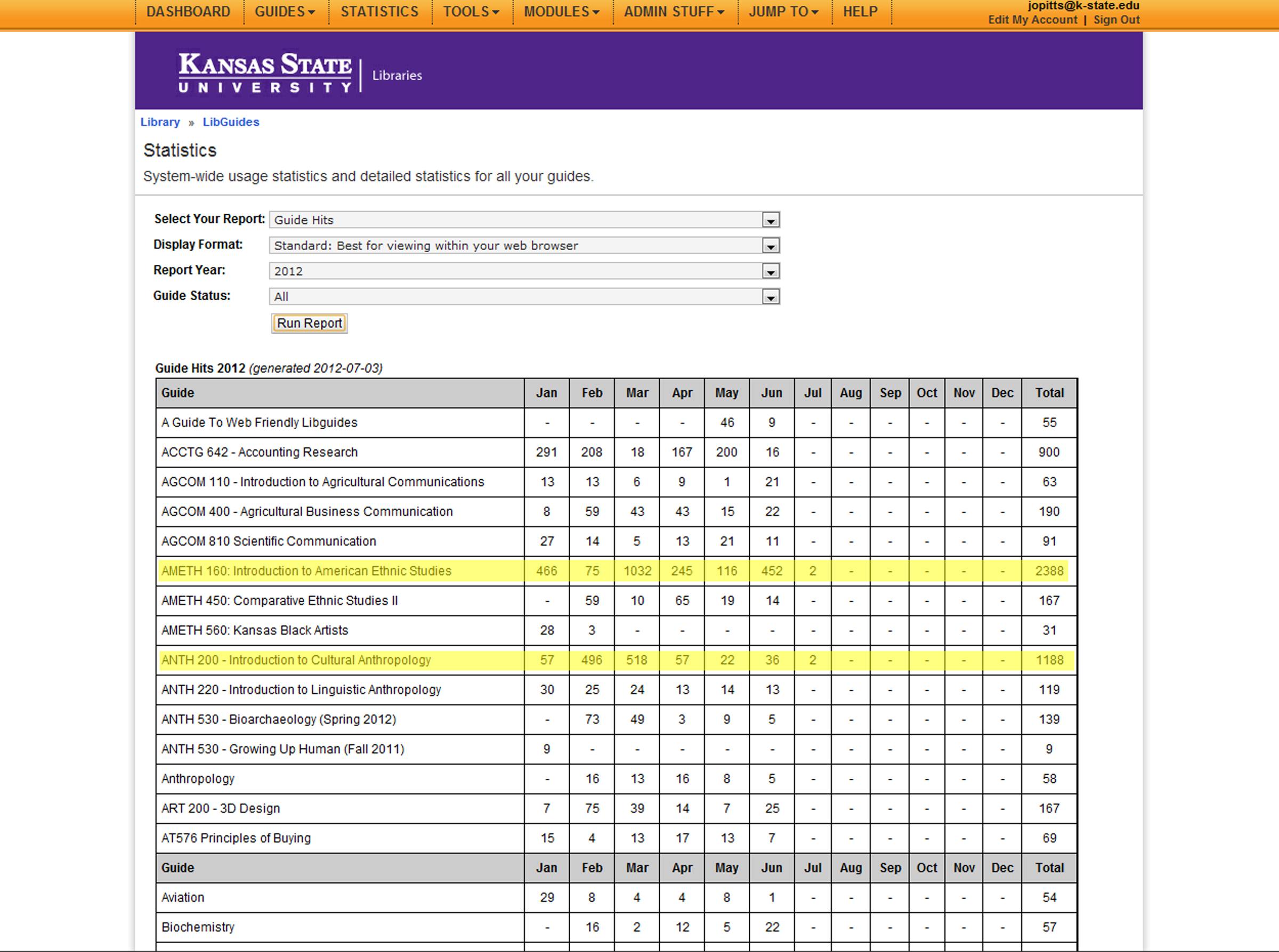
This dashboard view shows usage statistics for both the Introduction to American Ethnic Studies and Introduction to Cultural Anthropology (highlighted).
Home Page Hits
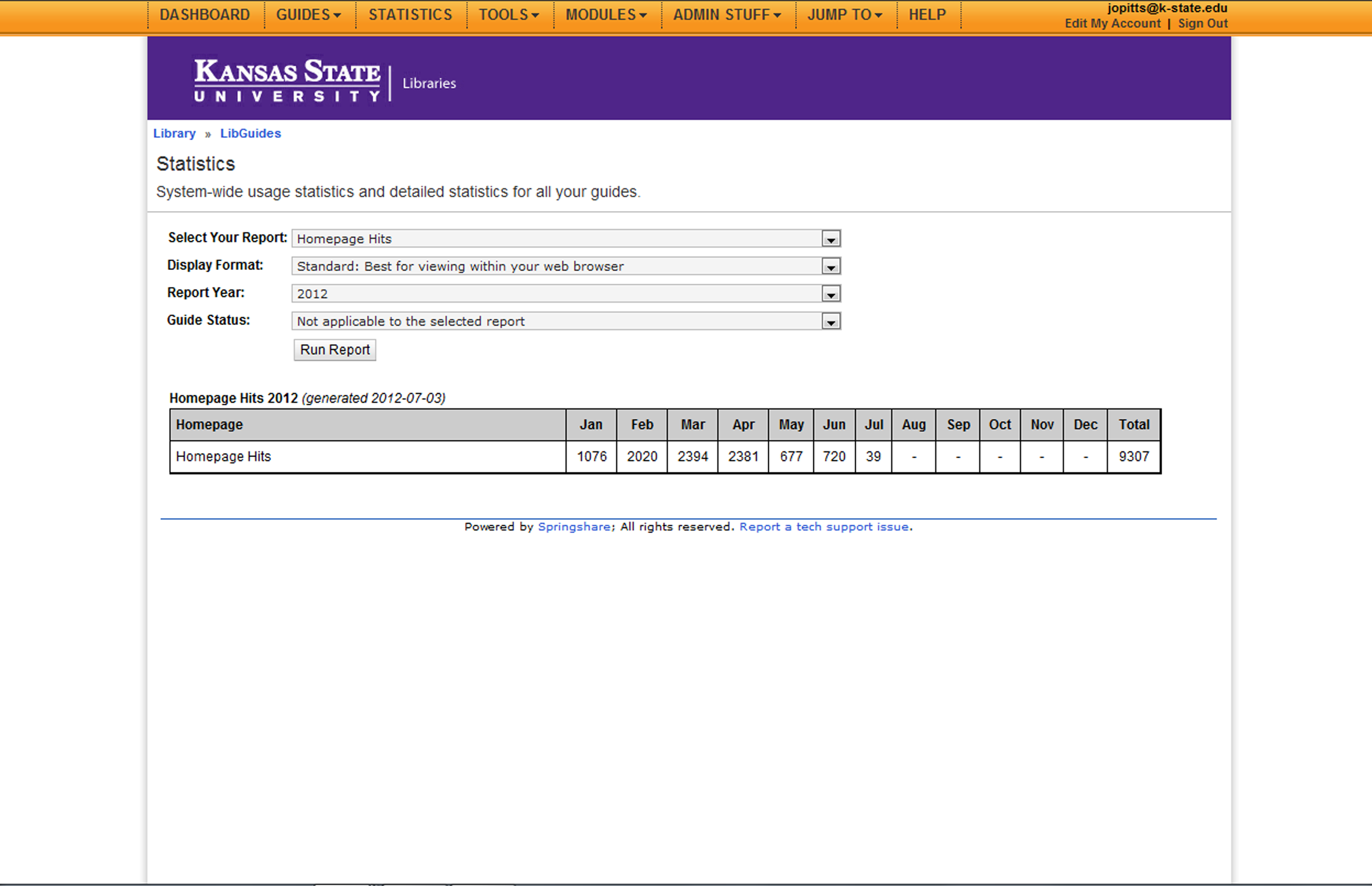
This screenshot shows the statistics for the home page of the K-State Libraries' Guides' home page.
Individual Guide (ANTH 200)
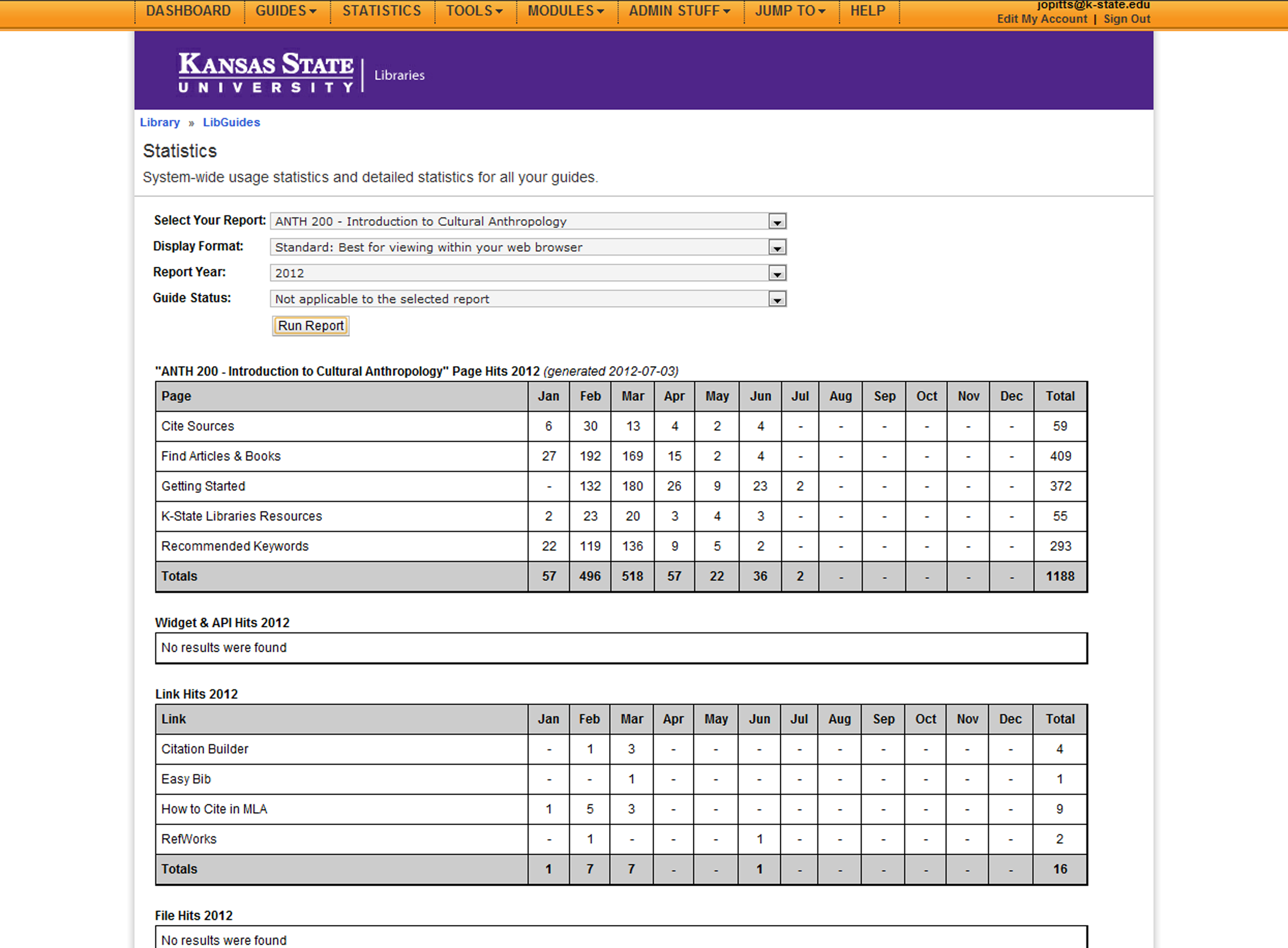
This screenshot shows the month-over-month usage statistics and other details of the ANTH 200 "Introduction to Cultural Anthropology."
Hale Library's Published LibGuides
To peruse their entire collection of published library guides, visit their main landing page.
Note: The Hale Library librarians have been tracking the number of LibGuides guide hits and the number of reference transactions for various months. They "believe there is a definite correlation between the two: reference transactions go down when LibGuide usage goes up." These guides are used for face-to-face instruction as well, and they are gathering data about the effectiveness of that this summer.
The back-end data was provided by Joelle Pitts, K-State librarian and faculty member. (Thanks!)
This was sent in courtesy of
David M. Lascu, MBA
Project Manager, Next Generation
Virtual Campus - Anne Arundel Community College
101 College Parkway - CADE 332
Arnold, Maryland 21012-1895
410.777.7078 (office)
443.804.6896 (cellular)
dmlascu@aacc.edu
Note: Mr. Lascu is looking for university partners to further extend the work of this project. Please contact him directly if you're interested. His contact information is above.
This section does not offer true "steps," but these are some initial points of consideration for the design of study guides for online learning.
Study Guide Contents and Presentation
What is the scope of the current study guide?
What contents need to be in a study guide?
What domain-specific contents?
Where will this information come from? How will it be cited?
How will the study guide be used in relation to the other course contents? Will these be integrated with the overall learning? The assessments?
How will the contents be designed and delivered?
Usage of the Study Guide
How will the learners use the study guide?
For an overview?
For synthesizing ideas?
For conducting some research?
For going through a simulation? A lab experiment?
For methodically learning in a real-world location?
For hands-on practice?
For experiential learning?
Will the study guide be integrated into the regular learning trajectory of the course?
SME Feedback to the Learner
What is the value-added for the learner?
Will the learner get quality feedback from the instructor? (Is there a feedback loop?)
Technologies
What technologies will be used for the study guide?
How will the study guide be accessible?
How will the study guide be printable? Portable / mobile?
Instructional Preferences
What is comfortable for the faculty member in terms of his / her instructional approach?
What information will the professor need for his / her teaching and learning?
Divergent Learning
If critical thinking and innovation are necessary (for divergent learning), what are the more advanced elements that will be integrated to create this?
Problem-solving challenges
Case studies
Scenarios
Projects
Collaborative Study Guides
If learners themselves are creating the study guide, what principles and guidelines are necessary to ensure that they use proper research and citation methods to build this study guide?
What are ways to ensure the quality of the collaborative study guide?
What are ways to ensure the accuracy of the collaborative study guide?
The Feedback Loop to the Instructor
How will the instructor know how effective / ineffective the study guide is?
What feedback have learners given about the study guide?
How can their comments be used to improve these study guides for future learners?
How can professors improve their teaching work based on learner feedback?
State-of-the-Art
What is the state-of-the-art for study guides for online courses? Trainings?
How has the state-of-the-art been achieved?
What aspects are worth emulation or derivation? Why?
"Steps" to Building Effective Study Guides for Online Learning and Assessment (downloadable)
Note: Online study guides should be built with the usual standards of accessibility, semantic soundness, and information hierarchy. Their ease-of-revision might suggest constant evolution for increasing learning value as new information is attained about their use. Their hosting in learning / course management systems (L/CMSes) and websites could enable back-end analytics to explore their use, and this information (along with learner qualitative feedback) may provide some information streams on how to improve these learning resources.
(These observations were added based on comments by participants in the live session. Thanks for your attendance!)
|
Dr. Shalin Hai-Jew Instructional Designer K-State 785-532-5262 shalin@k-state.edu
|
Acknowledgments: Thanks to the participants on the DEOS electronic mailing list for their ideas. Thanks to Joelle Pitts of K-State for her suggestion for including the customized study guides created by K-State's Hale Library and her generous provision of back-end analytics and analysis of their use.
Please Consider...
Call for Chapter Proposals: Packaging Digital Information for Enhanced Learning and Analysis: Data Visualization, Spatialization, Predictiveness, and Multidimensionality
Call for Chapter Proposals: Remote Workforce Training: Effective Technologies and Strategies